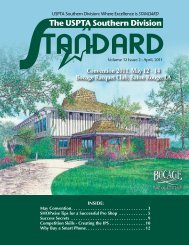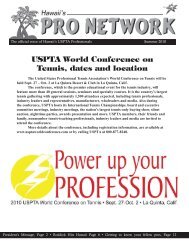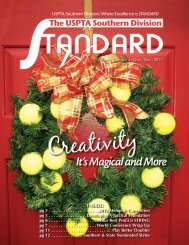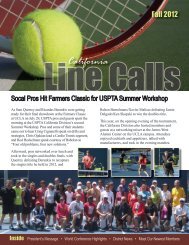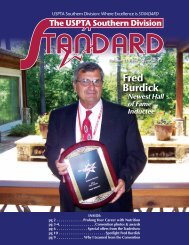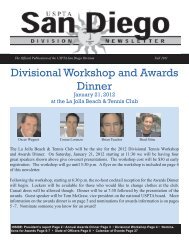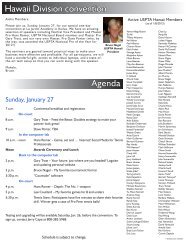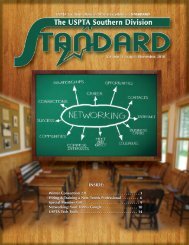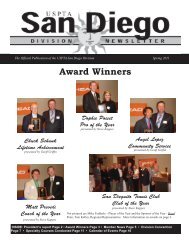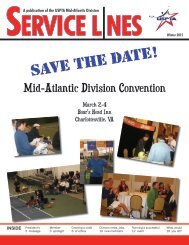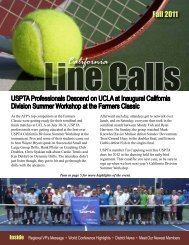Newsletter - USPTA divisions - United States Professional Tennis ...
Newsletter - USPTA divisions - United States Professional Tennis ...
Newsletter - USPTA divisions - United States Professional Tennis ...
Create successful ePaper yourself
Turn your PDF publications into a flip-book with our unique Google optimized e-Paper software.
The official voice of Hawaii’s <strong>USPTA</strong> <strong>Professional</strong>s Fall 2012<br />
Hawaii Pros attend <strong>USPTA</strong> World Conference<br />
Hawaii Division pros attended the <strong>USPTA</strong> World<br />
Conference the week of September 16-21 in beautiful<br />
Monterey, Calif. Pros attended educational<br />
classes, networked and reconnected with nationwide pros,<br />
and addressed current issues and future challenges facing<br />
all tennis teachers.<br />
The following Hawaii Pros and guests attended the conference:<br />
Kathleen Brady<br />
C G Bush<br />
Marc Casperino<br />
Liane DePontes<br />
Rusty Dyer<br />
Rudolph Embernate<br />
Kyle Kaneshiro<br />
Norma Kop<br />
Jose Higueras shares his wealth of knowledge.<br />
Randy Kop<br />
Beverly Nagel<br />
Bruce Nagel<br />
Ken Nakama<br />
Max Pavon<br />
David Porter<br />
Carolyn Thibault<br />
Beverly Nagel, former Hawaii resident and now <strong>USPTA</strong> Florida pro<br />
John Koahou, Bruce Nagel, and Ken Nakama pose for a shot at the<br />
Hawaii division party.<br />
Awesome and dedicated pros: Rusty Dyer and Carolyn Thibault<br />
More pictures, Page 4<br />
2012-2013 Awards, Page 3 • World Conference, Page 4 • Loving mixed doubles, Page 7 • Vision: an essential of shot making, Page 9
Ken Nakama<br />
President, Hawaii Division<br />
Board of Directors<br />
President<br />
Ken Nakama<br />
808-679-3197<br />
ken.nakama@marriott.com<br />
Regional vice president<br />
Bruce Nagel<br />
808-262-2057<br />
brucenagel@aol.com<br />
First vice president<br />
Rick Wilson<br />
rickw10spro@gmail.com<br />
Treasurer<br />
Henry Somerville<br />
808-395-3300<br />
henry_somerville@yahoo.com<br />
Past president<br />
Jerry Cape<br />
808-382-5968<br />
jerry_cape@yahoo.com<br />
Head tester<br />
Lee Couillard<br />
808-944-5835<br />
lcouillard@punahou.edu<br />
Executive administrator<br />
Julie Myers<br />
888-877-8232<br />
divisionea@uspta.org<br />
Pro 2 Network<br />
President’s message<br />
Aloha Hawaii Division Pros:<br />
As 2012 winds down, I’m glad two things are happening: that the economy has gotten<br />
better (at least from my perspective), and we have the great sport of tennis to share with<br />
others.<br />
It’s an exciting time with our new CEO John Embree as he installs his new vision.<br />
You can count on the Hawaii Division to be in great hands with the quality, knowledge,<br />
and expertise that our Hawaii Division pros have.<br />
2013 also brings a new slate of officers whose names will be released very shortly. Be<br />
on the lookout for an email from me.<br />
It’s also creeping up on that time of year again when we will be hosting our Hawaii Division<br />
conference. Like last year, we will have two Master <strong>Professional</strong>s coming! <strong>USPTA</strong><br />
National Vice President Gary Trost is a sought-after speaker who will be fun, engaging<br />
and informative. Hans Romer, whose club just hosted our world conference, will continue<br />
our technological education that we started successfully last year by promoting social<br />
media. Save the date, Sunday, Jan. 27, 2012, at Le Jardin Academy.<br />
The Hawaii Division Nominating Committee has completed their selection for next year’s<br />
slate.<br />
If there are any further nominations, they must be submitted by December 31 to be put on<br />
the ballot for a special January election. He/she must receive five nominations from fellow<br />
<strong>USPTA</strong> Hawaii members. For more information, call Ken Nakama at 620-3256.<br />
2013 Division Board Slate<br />
President: Bruce Nagel<br />
Regional Vice President: Lee Couillard<br />
1st Vice President: Rick Wilson<br />
2nd Vice President: Henry Somerville<br />
Treasurer: David Porter, Ed.D.<br />
Secretary: Carolyn Thibault<br />
Immediate Past President: Ken Nakama<br />
Save the Date!<br />
Hawaii Division Convention<br />
Sunday, January 27<br />
Le Jardin Academy
2012-2013 awards<br />
We need your help! It’s once again time to recognize our<br />
best teaching professionals from the <strong>USPTA</strong> Hawaii Division.<br />
We look forward to presenting these prestigious<br />
awards at the January 27 Awards Luncheon to those professionals<br />
who are truly deserving of such recognition for their contributions<br />
to the <strong>USPTA</strong>, the USTA and the game of tennis in general<br />
based on the January 2012-January 2013 time period. Please take<br />
careful consideration when nominating our members and be sure<br />
to include thorough detail to support your nomination(s).<br />
Please note also that the categories mentioned below are<br />
examples of award categories we have featured in the past. The<br />
Committee recognizes the need to present only meaningful<br />
awards and may choose not to fill in or pigeonhole every category.<br />
We need your input as to who deserves meaningful recognition<br />
for their achievements in the past year.<br />
Mahalo for your votes and please email all nominations to<br />
the following no later than January 14, 2013.<br />
Julie Myers<br />
Hawaii Executive Administrator<br />
julie.myers@uspta.org<br />
<strong>Professional</strong> of the year: Made significant contributions to<br />
<strong>USPTA</strong> Hawaii Division, USTA and actively involved in the community,<br />
publications, special programs, services and the tennis<br />
industry as a whole.<br />
Assistant professional of the year: A professional who<br />
proved to be an essential asset while assisting the director of<br />
tennis, head professional or any organizational leader or tennis<br />
program.<br />
Rookie of the year: A new professional who made outstanding<br />
strides in the tennis community in just the first year of his/her<br />
certification.<br />
Open player of the year (male or female): Had outstanding<br />
<strong>USPTA</strong>, USTA and/or ITF Open tournament play results. Official<br />
rankings and other results will also be considered.<br />
Senior player of the year (male or female): Had outstanding<br />
<strong>USPTA</strong>, USTA and/or ITF tournament play results in the<br />
45+ age <strong>divisions</strong>. Official rankings and other results will also be<br />
considered.<br />
Facility of the year: Encouraged professional development of<br />
staff and fellow professionals, promoted tennis in a club, commercial<br />
tennis facility, public tennis program or hotel/resort<br />
environment. This facility supported <strong>USPTA</strong> education, hired<br />
<strong>USPTA</strong> <strong>Professional</strong>s, hosted tournament/league competition,<br />
made special contributions to the game and is affiliated with<br />
various industry organizations.<br />
High school coach of the year: Developed enthusiasm and<br />
had permanent influence on high school team players.<br />
College coach of the year: Developed enthusiasm and had<br />
permanent influence on collegiate team players.<br />
Community service award/special recognition award: A<br />
<strong>USPTA</strong> professional who has meaningfully served and bettered<br />
the community for altruistic reasons, irrespective of his or her<br />
professional development, profit or advancement.<br />
Pro 3 Network
Scenes from the World Conference<br />
It was a nice change from Hawaii’s sunny climate to observe the<br />
classes in cool, crisp weather.<br />
Hawaii pros and friends enjoyed dinner and camaraderie at the Loose<br />
Noodle Company.<br />
Kyle Kaneshiro and Rosie<br />
Bareis at the Hawaii Division<br />
Pa’ina.<br />
Pro 4 Network<br />
Warren Lem and Ken Nakama<br />
Norma Kop with famous pro Vic<br />
Braden. Laugh and win!<br />
Bruce joking around at the<br />
Hawaii Division party.<br />
Past presidents Ron Woods and Dave Porter, along with CEO Tim<br />
Heckler joined the Hawaii Division for some good times.<br />
Wailae C.C. Director Randy Kop (left), Kailua Racquet Club GM<br />
Bruce Nagel (right), and our terrific Executive Administrator Jill<br />
Phipps!
Hawaii Pro Kyle Kaneshiro honored<br />
at Awards Breakfast<br />
Kyle Kaneshiro of Honolulu, Hawaii, received the Lessons<br />
for Life Individual Award for his all his efforts<br />
in the tennis community as director of tennis at<br />
Moanalua High School, including raising $200,000 for the<br />
Moanalua High School <strong>Tennis</strong> Lights Project.<br />
Kaneshiro has been the director of tennis at Moanalua<br />
High School for 13 years and has done much for the tennis<br />
community during that time. The courts at Moanalua High<br />
School had been without lights since 2009 after they were<br />
removed due to safety issues because of corrosion, and as<br />
a result the facility was forced to discontinue a majority of<br />
its tennis programs.<br />
With the help of family, friends, students and parents,<br />
Kaneshiro was able to raise the $200,000 within two years<br />
by hosting golf and tennis tournaments, through grants<br />
and donations and tennis clinics. The project was finally<br />
completed in November 2011.<br />
He continues to use the courts to give back to the<br />
community. He has hosted events supporting the Hawaii<br />
Children’s Cancer Foundation and he has hosted free clinics<br />
for kids in the Free Judiciary Juvenile Drug Court Clinic<br />
and at Moanalua Elementary School.<br />
Kyle Kaneshiro receives his award from <strong>USPTA</strong> President Tom<br />
Daglis at the <strong>USPTA</strong> Awards Breakfast.<br />
Bruce and Beverly Nagel Bruce and Ken at the Executive Committee meeting.<br />
Pro 5 Network
Hawaii’s David T. Porter named<br />
<strong>USPTA</strong> <strong>Professional</strong> of the Year<br />
David T. Porter, Ed.D.,<br />
of Laie, Hawaii, who<br />
has been involved<br />
in teaching tennis for more<br />
than 35 years and has been<br />
a <strong>USPTA</strong> member for more<br />
than 25 years, received the<br />
<strong>United</strong> <strong>States</strong> <strong>Professional</strong><br />
<strong>Tennis</strong> Association’s Alex<br />
Gordon Award for the <strong>Professional</strong><br />
of the Year.<br />
Porter was recognized<br />
during the <strong>USPTA</strong>’s annual<br />
awards breakfast at<br />
its World Conference on<br />
<strong>Tennis</strong>. The <strong>USPTA</strong>, the<br />
world’s oldest and largest<br />
association of tennis-teaching<br />
professionals, hosted its<br />
annual World Conference<br />
Sept. 16-21 at the Hyatt<br />
Regency Monterey Hotel &<br />
Spa in Monterey, Calif.<br />
The professional of<br />
the year is judged in seven<br />
areas, including: contributions<br />
to <strong>USPTA</strong> and USTA;<br />
as a teaching professional,<br />
player and coach; education,<br />
research and publications;<br />
organizational affiliations;<br />
and contributions to the<br />
community.<br />
Porter, who is a <strong>USPTA</strong><br />
Master <strong>Professional</strong>,<br />
played collegiate tennis for<br />
Brigham Young University,<br />
a top 20 Division I program.<br />
Porter graduated with<br />
Ed.D., M.S. and B.S. degrees<br />
before beginning his tennisteaching<br />
career.<br />
He has been very committed<br />
to the <strong>USPTA</strong>. He<br />
has been a Head Tester<br />
since 1988 and has served<br />
on the National Board from<br />
Pro 6 Network<br />
1994-2007. This included<br />
serving as the national<br />
president from 2003-2005.<br />
In addition, he has served as<br />
the chairman of the education<br />
committee and the<br />
chairman of the testing and<br />
certification committee. He<br />
has also been a speaker at<br />
numerous <strong>USPTA</strong> divisional<br />
conventions and national<br />
conferences.<br />
He is currently the head<br />
tennis coach at Brigham<br />
Young University – Hawaii.<br />
Porter has an impressive<br />
record of 1,193 wins and<br />
145 losses over his college<br />
coaching career, and he<br />
has never lost a conference<br />
match in women’s tennis<br />
during his entire career. His<br />
BYU – Hawaii women’s<br />
team is the three-time<br />
Pacific West Conference<br />
champions (2010, 2011,<br />
2012). He has also taught/<br />
worked with several nationally<br />
ranked players, including<br />
Zheng Jie, ranked No. 15<br />
in the WTA, Yan Zi, ranked<br />
in the top 100 in the WTA<br />
and Li Na, ranked top 10 in<br />
the WTA.<br />
Porter has written several<br />
articles for China <strong>Tennis</strong><br />
Club magazine and AD-<br />
Dvantage magazine. Also, as<br />
the chairman of the <strong>USPTA</strong><br />
Player Development Advisory<br />
Council, he consulted<br />
and edited “The Six General<br />
Performance Components<br />
of <strong>Tennis</strong>.”<br />
He is currently on the<br />
HEAD Penn Racquet Sports<br />
Advisory Committee and<br />
Nike China Advisory Committee.<br />
His previous accolades<br />
include Hawaii Division<br />
Pro of the Year (2004,<br />
1995), <strong>USPTA</strong> College<br />
Coach of the Year (2003,<br />
2002), Hawaii Division Tester<br />
of the Year (1997, 1994),<br />
and Hawaii Division Hall of<br />
Fame Inductee (1985).
Loving mixed doubles<br />
Growing up in my<br />
native Netherlands,<br />
playing mixed<br />
doubles was, and still is,<br />
an important part of team<br />
competition. The Royal<br />
Dutch <strong>Tennis</strong> Association<br />
(KNLTB) has structured<br />
the match format in such<br />
a way that two decisive<br />
matches can determine<br />
the outcome of the entire<br />
day, even at the highest<br />
level. Four singles matches,<br />
one men’s doubles, one<br />
women’s doubles, and two<br />
mixed doubles keep a total<br />
of eight players (four on<br />
each team) busy all Sunday<br />
in the spring. Each match<br />
is worth one point, and<br />
since the mixed doubles<br />
are scheduled last, you can<br />
imagine the pressure on<br />
these final two matches.<br />
However, no matter how<br />
fierce the competition is,<br />
afterward we all enjoy “bitter-balls”<br />
(a typical Dutch<br />
snack) and a cold Heineken<br />
with our opponents!<br />
While competing<br />
on the weekends, I was<br />
enjoying my first years as<br />
a teaching professional at<br />
a medium-sized club, just<br />
outside Amsterdam. Teaching<br />
tennis, or teaching<br />
anything for that matter,<br />
is a very rewarding career.<br />
Seeing students, young and<br />
old, developing athletic<br />
skills and having a good<br />
time while doing it, is a<br />
goal many teaching profes-<br />
sionals take pride in. Let’s<br />
face it, tennis is the perfect<br />
vehicle - especially for<br />
juniors - to connect with<br />
other people. Hitting tennis<br />
balls, running around the<br />
court, being with friends,<br />
participating in healthy<br />
competition in a safe environment,<br />
are ingredients<br />
that not every after-school<br />
activity can offer. Even<br />
though I was only in my<br />
mid-20s, I recognized the<br />
importance of providing<br />
these kids with more than<br />
just tennis. Good attitudes,<br />
being courteous, fair play,<br />
being polite and respectful,<br />
were just some of the<br />
traits I integrated in my<br />
lessons and clinics, without<br />
necessarily emphasizing<br />
it. Respecting the game, I<br />
also felt that educating the<br />
juniors about the history,<br />
rules and etiquette was one<br />
of my responsibilities as a<br />
coach.<br />
On a beautiful sunny<br />
Wednesday afternoon, during<br />
a Peewee class, I asked<br />
the young rascals if they<br />
were aware of all the different<br />
playing formats. “When<br />
two boys play together,<br />
what do you call that”? I<br />
asked. At first they didn’t<br />
have a clue where I was going<br />
with this question, so I<br />
answered for them, “That’s<br />
called boys singles.” How<br />
about two girls? Daphne,<br />
a bright girl, answered,<br />
“Girls singles!” All the other<br />
A true story by Hans Römer<br />
Hans Romer enjoys the game of mixed doubles – and hearing<br />
children’s unique take on it.<br />
kids recognized the logic,<br />
but were speechless when<br />
I presented them with the<br />
next question, “How about<br />
when two boys play against<br />
two boys?” For a moment I<br />
lost them again and explained<br />
that was called<br />
boys doubles. Daphne took<br />
charge again, and before I<br />
even imposed the question<br />
on the group, she stated,<br />
“When two girls play<br />
against two girls, it’s called<br />
Girls Doubles!” I replied,<br />
“That’s exactly right, good<br />
job Daphne!” My last obvious<br />
question was, “Now<br />
what if a boy and a girl<br />
play together?” Little Anna,<br />
who had been quietly paying<br />
attention, gave me the<br />
This article is reprinted with permission from ADDvantage magazine, July 2011.<br />
most precious answer in<br />
my entire teaching career.<br />
Without hesitation, she<br />
said, “Making love!”<br />
Hans Römer, <strong>USPTA</strong> Master<br />
<strong>Professional</strong>, is the director of<br />
tennis at the Monterey <strong>Tennis</strong><br />
Center in California. He has<br />
been a speaker at numerous<br />
tennis conventions. He also is<br />
a member of the <strong>United</strong> <strong>States</strong><br />
<strong>Tennis</strong> Writers Association and<br />
the USA correspondent for <strong>Tennis</strong><br />
Journal, a Dutch magazine.<br />
Römer graduated in his native<br />
Netherlands from the prestigious<br />
CIOS Sport College with a B.A.<br />
degree in physical education and<br />
studied pedagogy at the University<br />
of Amsterdam.<br />
Pro 7 Network
Pro 8<br />
Network
Vision – an essential of shot making<br />
Technique, speed, agility, footwork,<br />
strength, mental toughness<br />
and match strategies have<br />
always been the main criteria in<br />
judging tennis ability. And all tennistraining<br />
programs have been designed<br />
with those criteria in mind, even<br />
though our body will only respond to<br />
what it can see. Despite this fact, little<br />
attention has been paid to vision.<br />
For decades, players have been<br />
told to “watch the ball” or “keep your<br />
eye on the ball.” These phrases seem<br />
to be a maxim that should solve this<br />
problem when playing tennis. Remember,<br />
it’s not hard to know what<br />
to do, but how to do what you know!<br />
Not watching the ball is typically due<br />
to “visual wandering” and a lack of<br />
visual discipline/training. Running,<br />
acceleration, eye movement and the<br />
speed of the ball are the visual spoilers.<br />
Try reading a newspaper and running<br />
on the spot. You will notice that<br />
the running caused difficulty reading<br />
the newspaper.<br />
By undertaking a simple visual<br />
training program, a tennis player<br />
can improve his performance. That’s<br />
because the eye, like the muscles in<br />
our bodies, can be strengthened to<br />
perform better with exercise. By seeing<br />
better, you can play better because<br />
what and how you see, is what and<br />
how you will do.<br />
Some of the required visual skills<br />
that can be enhanced through training<br />
are:<br />
Head positioning<br />
Dynamic visual acuity<br />
Eye tracking<br />
Eye teaming & depth perception<br />
Peripheral vision and<br />
Eye-hand coordination.<br />
Head positioning: The average adult<br />
head weighs 12 – 15 pounds. When the<br />
head is moved excessively in order to<br />
see, we risk throwing the whole body<br />
out of balance. Thus, players need the<br />
ability to identify and feel their head<br />
positioning during strokes.<br />
Dynamic visual acuity: Playing tennis<br />
is a visual stress test. It requires more<br />
from your eyes than the daily activities<br />
of reading the newspaper and working<br />
on the computer. The player who<br />
sees the ball late and exercises poor<br />
visual judgment is at a distinct disadvantage.<br />
An aggressive player will<br />
move around the court, which tires<br />
and weakens your visual judgment of<br />
ball placement and speed. Running<br />
impairs visual acuity; many errors<br />
occur after a player has been forced to<br />
run for a shot. The solution, of course,<br />
is preparation. You can hone dynamic<br />
visual acuity so that you can function<br />
optimally in matches in which the ball<br />
is hit hard and you are forced to run a<br />
great deal. The two factors that make<br />
seeing the ball difficult are your motion<br />
and the speed of the ball. Thus,<br />
players need the ability to see the ball<br />
more effectively and efficiently while<br />
the player and the ball are moving.<br />
Eye tracking: This is the ability to<br />
follow a moving object smoothly and<br />
accurately with both eyes. In tennis,<br />
it is desirable to track the ball to the<br />
moment of contact, that is to “see the<br />
ball hit the racquet.” But, according to<br />
Feisal Hassan, <strong>USPTA</strong> Master <strong>Professional</strong><br />
Eyes, like the muscles in our bodies, can be strengthened to perform better with<br />
exercise.<br />
Jack Groppel, Ph.D., a tennis ball contacting<br />
the strings happens way too<br />
fast to see with the human eye. The<br />
comparison he offers is of a normal everyday<br />
60-cycle deck lamp. The light<br />
of this standard lamp seems steady<br />
enough, but actually it is flickering on<br />
and off 60 times every second, so fast<br />
that it appears to be a steady beam<br />
of light. Have any of us ever seen this<br />
light either on or off? No. The reason is<br />
that it simply turns off and on too fast<br />
for the human eye to record. According<br />
to Groppel, the moment of a tennis<br />
racquet striking a ball takes less time<br />
than a 60-cycle light flickers on and<br />
off.<br />
It takes 1/10th of a second to<br />
relate information from the eyes to<br />
the brain. Research by the LTA shows<br />
that watching the ball only occurs<br />
5-6 feet in front of the player, so after<br />
this (tracking the ball), de-emphasize<br />
watching the ball, emphasize getting<br />
into the right position and bring your<br />
eyes to the point of contact. We need<br />
to “anticipate” and pay attention to<br />
preparation – where the ball is going<br />
to be and when it’s going to be there.<br />
Eye teaming & depth perception:<br />
This is the ability to use both eyes<br />
together (in unison) and to judge<br />
Continued next page<br />
Pro 9 Network
Continued from page 9<br />
relative distances of objects and to<br />
see and move accurately in threedimensional<br />
space. Although we look<br />
at the world with both eyes, we are<br />
aware of only a single impression of<br />
the environment. When the eyes work<br />
together as a team, the perceptions<br />
of each eye are coordinated. Depth,<br />
for example, is perceived when<br />
two-dimensional images received by<br />
each eye are fused in the brain into<br />
one three-dimensional image. As a<br />
result, we can judge distance easily<br />
and locate objects in space. On the<br />
other hand, anyone whose eyes do not<br />
team up finds it very difficult to judge<br />
distance.<br />
Peripheral vision: This is the ability<br />
to maintain and interpret what is<br />
happening on the court (in your side<br />
vision) while attending to the ball<br />
(the specific central vision). Think<br />
of a wide receiver in football. When<br />
a pass is thrown in his direction, he<br />
must focus on the ball, the opponent<br />
Pro 10 Network<br />
trying to prevent him from making the<br />
catch, and his feet in relation to the<br />
sideline. If he does not account for all<br />
three things, he won’t be consistently<br />
successful. The same thing applies to<br />
tennis. A player must concentrate on<br />
the incoming ball, account for his own<br />
position on the court and what his<br />
opponent is doing across the net. All<br />
three are crucial for a player’s “triple<br />
vision.”<br />
Eye-hand coordination: This is how<br />
the visual system guides the motor<br />
system.<br />
The eyes lead the hands – not the<br />
other way around. Coaches and players<br />
who refer to “hand-eye coordination”<br />
have missed the significance of<br />
this relationship. The visual system<br />
leads the motor system.<br />
We all use eye-hand coordination<br />
in our daily lives and take this skill for<br />
granted.<br />
Driving a car requires constant<br />
coordination between vision and<br />
hands and feet. Turning a car at an<br />
intersection requires the processing<br />
of visual information by the brain and<br />
an immediate reaction by the hands<br />
on the steering wheel to the brain’s<br />
command. Parallel parking, a more<br />
difficult task, requires a series of quick<br />
adjustments between the visual system<br />
and the hands and feet. Braking is<br />
a good example of eye-foot coordination.<br />
When we want to stop or slow<br />
down, the foot controls the brake<br />
pedal, but our vision first processes<br />
the information that tells us where<br />
and when to brake.<br />
The goals of this article are:<br />
1. To demonstrate a simple on-court<br />
vision training program which<br />
will improve the performance of a<br />
tennis player.<br />
2. To coordinate the proper eye<br />
movements with the body.<br />
3. To make quick and accurate decisions<br />
on the court.<br />
The vision training program<br />
The vision training program is<br />
broken down into six types and levels<br />
of exercises:
Level 1: head positioning exercises<br />
Level 2: dynamic visual acuity exercises<br />
Level 3: eye tracking exercises<br />
Level 4: eye teaming & depth perception<br />
exercises<br />
Level 5: peripheral vision exercises<br />
Level 6: eye-hand coordination exercises<br />
Level 1. Head positioning exercises<br />
Purpose: to help players identify<br />
and feel the head positioning during<br />
strokes<br />
A. General head positioning<br />
The head should remain above<br />
center of gravity and stay relatively<br />
still at all times. The more your head<br />
is over your center of gravity, the more<br />
efficient your visual tracking, balance,<br />
strokes and recovery. If the head gets<br />
too far off the center of gravity as you<br />
move to the shot, you will have difficulty<br />
hitting in balance, control and<br />
recovery.<br />
Drill: upside-down cap (or folded<br />
towel)<br />
Place a cap upside-down or a<br />
folded towel on your head. Balls could<br />
be hit to you, or points played out.<br />
Your goal is to keep the cap or folded<br />
towel on your head.<br />
The dominant eye is the eye that<br />
sends information to the brain quicker<br />
than the non-dominant eye. The brain<br />
gets the information a few milliseconds<br />
faster. And since the brain gets<br />
the information quicker, the body<br />
reacts quicker. Research shows that<br />
the dominant eye’s connection with<br />
the brain is 10-13 times faster than the<br />
non-dominant eye.<br />
The test to determine the dominant<br />
eye is a simple one. Make a circle<br />
with both hands about the size of a<br />
tennis ball. Then look through this<br />
circle at a fixed object about 15-20 feet<br />
away. Next, while holding your line<br />
of sight on the object, close your left<br />
eye and look through the circle at the<br />
object with your right eye. If you can<br />
still see the object through the circle,<br />
you are right-eye dominant. On the<br />
other hand, if you can no longer see<br />
the object through the circle, you are<br />
left eye dominant.<br />
B. Head positioning for groundstrokes:<br />
The goal on the groundstrokes<br />
is to get the dominant eye<br />
closer to the ball.<br />
TIP: Make sure your opponent can see<br />
both your eyes when you are tracking<br />
the ball.<br />
C. Head positioning for volleys: The<br />
goal is to get your head at the same<br />
level as your racquet head when lining<br />
up for the ball.<br />
D. Head positioning for serves/overheads:<br />
players typically drop their<br />
head prior to hitting the ball.<br />
Tip: Keep your head up by keeping<br />
your non-dominant hand up “longer”<br />
(until the follow-through). Think of<br />
an outfielder in baseball getting ready<br />
to catch the ball.<br />
All stroke drill: Keep a pencil behind<br />
your ear. Play points. If the pencil falls<br />
anytime during the point, the opponent<br />
wins the point.<br />
Level 2. Dynamic visual acuity exercises<br />
Purpose: to help players see the ball<br />
more effectively and efficiently while<br />
the player and ball are moving.<br />
Drill: two-ball rally<br />
Players have a ball in one hand. On<br />
the count of three, both players feed<br />
their ball to the other player and try<br />
rallying cooperatively with two balls<br />
in play.<br />
Drill: colored ball<br />
Have a basket of balls with different<br />
colored balls in it, e.g., yellow,<br />
orange and white.<br />
If the ball fed to you is an orange<br />
ball, you hit a forehand; a white ball,<br />
you hit a backhand; a yellow ball, you<br />
hit a lob.<br />
Another variation could be using<br />
the same stroke. For example, if you<br />
get a white ball, you hit a forehand<br />
crosscourt; if you get an orange ball, you<br />
hit a forehand down-the-line; if you get a<br />
yellow ball, you hit a forehand lob.<br />
Level 3. Eye tracking exercises<br />
Purpose: to develop the ability to<br />
follow a moving ball smoothly and accurately<br />
with both eyes.<br />
Drill: ball characteristics<br />
Use command words (or trigger<br />
words) to identify the ball characteristics.<br />
Shout out the words as soon as<br />
you have identified the characteristics.<br />
Initially do one characteristic at a<br />
time:<br />
Ball Trigger words<br />
characteristics<br />
Spin top, slice, flat<br />
Speed slow, med., fast<br />
Direction right, left<br />
Depth short, middle, deep<br />
Height low, medium, high<br />
Drill: distraction rally<br />
Rally normally from the baseline,<br />
while two other players are diagonally<br />
across from each other at the net hitting<br />
volleys (or touch shots) back and<br />
forth simultaneously.<br />
Level 4. Eye teaming & depth perception<br />
exercises<br />
Purpose: to develop the ability for<br />
your eyes to function in unison and to<br />
judge relative distances of the ball and<br />
to see accurately in three-dimensional<br />
space.<br />
Drill: “in-out”<br />
You are at net. Coach or another<br />
player feeds from the opposite baseline<br />
with different speeds, heights,<br />
spins, directions and depths. You call<br />
“in” or “out” based on ball going past<br />
you. A third person can stand on the<br />
baseline acting as the line judge.<br />
Drill: 4-quadrant<br />
Divide court into four quadrants<br />
by extending the center service line<br />
all the way back to the baseline. With<br />
the line extended, the court has four<br />
boxes or quadrants. Number each<br />
quadrant from one to four. As the ball<br />
goes over the net, you must call out<br />
the quadrant number that the ball is<br />
going to land in.<br />
Level 5. Peripheral vision exercises<br />
Continued page 13<br />
Pro 11 Network
<strong>USPTA</strong> announces plans to move forward<br />
Tim Heckler to retire in December 2012 and John Embree named<br />
as new CEO/Executive Director<br />
The <strong>USPTA</strong> has announced plans<br />
to move forward following Tim<br />
Heckler’s retirement as chief executive<br />
officer effective Dec. 31, 2012,<br />
after 30 years in the position.<br />
Heckler announced<br />
his intent<br />
to retire earlier this<br />
year and the Board<br />
of Directors also<br />
offered Heckler a<br />
one-year severance<br />
package through<br />
the end of 2013,<br />
which was ratified<br />
Tim Heckler<br />
by a vote of the entire Executive Committee<br />
in April.<br />
The Board of Directors and Search<br />
Committee recently hired industry<br />
veteran John Embree as the new CEO/<br />
Executive Director. Embree began<br />
transitioning into his role as of Oct. 1<br />
and will be relocating to the national<br />
office in Houston on Nov. 1.<br />
The association conducted a search<br />
for the new CEO/Executive Director,<br />
and after interviewing several candidates<br />
in conjunction with the executive<br />
search firm, GSI Executive Search<br />
Inc., the <strong>USPTA</strong> Search Committee<br />
offered the position to Embree. The<br />
contract was ratified by the <strong>USPTA</strong><br />
Executive Committee in late August.<br />
“The <strong>USPTA</strong> is indebted to Tim<br />
Heckler for taking <strong>USPTA</strong> to the next<br />
level, and his 30 years of service as<br />
CEO is a demonstration of his passion,<br />
his commitment to the association,<br />
and his endless hard work for helping<br />
and improving the well-being of the<br />
tennis-teaching professional,” President<br />
Daglis said.<br />
When Heckler, who is a <strong>USPTA</strong><br />
Master <strong>Professional</strong>, was tapped as<br />
<strong>USPTA</strong> CEO in 1982, the organization<br />
Pro 12 Network<br />
had approximately 2,400 members<br />
and an annual budget of $700,000.<br />
Today, the association is the world’s<br />
oldest and largest organization of its<br />
kind, serving more than 15,000 members<br />
in 66 countries, and operating on<br />
an annual budget of $6.5 million. Also,<br />
the association’s equity has grown<br />
from $60,000 in 1982 to more than<br />
$4.2 million today.<br />
Heckler, who began playing tennis<br />
at age 3, started his tennis-teaching<br />
career in 1970, the same year he joined<br />
<strong>USPTA</strong>. He was elected president of<br />
the <strong>USPTA</strong> Texas Division in 1974<br />
and served as national president of the<br />
organization from 1980 to 1982.<br />
With Heckler’s guidance, <strong>USPTA</strong><br />
became one of the first tennis organizations<br />
to embrace technology, first<br />
through the computerization of the<br />
business itself as early as 1982, and<br />
then later through its use of the Internet<br />
and email-based communications<br />
and education. <strong>USPTA</strong> introduced its<br />
first website in 1995.<br />
The <strong>USPTA</strong> honored Heckler in<br />
2000 by naming him a grand inductee<br />
in the Association’s Hall of Fame.<br />
He also received the International<br />
<strong>Tennis</strong> Hall of Fame’s <strong>Tennis</strong> Educational<br />
Merit Award in 2002 and was<br />
inducted into the Texas <strong>Tennis</strong> Hall<br />
of Fame in 2005. In 2008 he received<br />
the highest honor awarded by the<br />
<strong>United</strong> <strong>States</strong> <strong>Professional</strong> <strong>Tennis</strong> Association,<br />
the George Bacso Lifetime<br />
Achievement Award.<br />
“We are pleased to welcome<br />
John Embree into the <strong>USPTA</strong> family.<br />
His vast tennis industry expertise,<br />
contacts, and company management<br />
skills will serve the <strong>USPTA</strong> well,” said<br />
President Tom Daglis.<br />
Embree has held a wide variety of<br />
influential tennis<br />
industry roles<br />
for more than<br />
30 years. They<br />
include serving as<br />
President of Prince<br />
Sports, The Americas;<br />
President of<br />
Balle de Match<br />
John Embree<br />
LLC; and Vice<br />
President/General Manager, Racquet<br />
Sports Division for Wilson Sporting<br />
Goods Co. Most recently, he launched<br />
a tennis consulting practice to assist<br />
endemic brands, associations and new<br />
corporate entities in maximizing their<br />
impact in the tennis marketplace. His<br />
client list included the USTA, Intercollegiate<br />
<strong>Tennis</strong> Association, Peter<br />
Burwash International, Off the Grid<br />
Technologies, and Donnay USA.<br />
Embree has served on many national<br />
USTA Committees, including<br />
the USTA Nominating Committee in<br />
2005-2006 and currently as the Vice<br />
Chair of USTA <strong>Professional</strong> Circuits<br />
Committee. In addition, he recently<br />
served as Presidential appointee of the<br />
Board of Directors of USTA Middle<br />
<strong>States</strong> section, is a past member of<br />
TIA Board of Directors and Executive<br />
Committee, member of the Board<br />
of Directors of American College of<br />
Sports Medicine Foundation, and<br />
past President of the Chicago <strong>Tennis</strong><br />
Patrons Foundation. One of his proudest<br />
achievements in tennis was the<br />
creation of the USTA Adult League<br />
<strong>Tennis</strong> program in 1980, when he<br />
served as the first USTA Adult League<br />
<strong>Tennis</strong> Administrator for two years.<br />
He earned a bachelor’s degree from<br />
Washington & Lee University in Lexington,<br />
VA, and was inducted into the<br />
W&L Athletic Hall of Fame in 2005.
Continued from page 11<br />
Purpose: to develop the ability to<br />
monitor and interpret what is happening<br />
on the court (in your side vision)<br />
while attending to the ball (the specific<br />
central vision)<br />
Drill: ball training<br />
Have a partner (holding two<br />
balls) standing 3 to 4 feet from you.<br />
The balls are thrown to you simultaneously,<br />
and you must catch one ball<br />
in each hand. As you improve, cross<br />
your arms to make the catch.<br />
Drill: hand signals<br />
While rallying, have your partner<br />
make hand signals (fist, open fist,<br />
thumb up or thumb down) to see if<br />
you can recognize what the signals<br />
are.<br />
Level 6: eye-hand coordination exercises<br />
Purpose: to train a player to effectively<br />
develop how their visual system<br />
guides their motor system<br />
Serve drill: two-ball collision<br />
Have a ball in each hand. Mimic<br />
the serve motion and release both balls<br />
to try to make both balls “collide” or<br />
hit each other. This is great, not only<br />
for an eye-hand coordination drill but<br />
also great to develop synchronization<br />
of the hands on the serve.<br />
Return of serve drill: racquet handle<br />
return<br />
You must return serve with the<br />
racquet handle (or grip).<br />
Groundstroke drill: rally<br />
Rally from the baseline, but rotate<br />
the racquet around your body two<br />
times after each hit.<br />
Net play drill: volley-rally<br />
Players volley back and forth<br />
switching the dominant hand from the<br />
grip to throat of the racquet after each<br />
volley. This drill emphasizes eye-hand<br />
coordination with respect to the point<br />
of contact and getting used to muscle<br />
tension and relaxation.<br />
Another variation is to switch the<br />
racquet from one hand to the other<br />
after each hit.<br />
Trying to develop watching the<br />
ball and judging the ball flight skills<br />
are challenging tasks for any player.<br />
This article is an example on how<br />
this might be achieved. The drills<br />
presented are just some on-court<br />
examples and should only serve as<br />
guidelines. I have had success with<br />
this program.<br />
In summary, I believe a good vision<br />
training program should always<br />
lead to:<br />
• controlling the head positioning<br />
and movement<br />
• developing the following visual<br />
skills:<br />
• dynamic visual acuity<br />
• eye tracking<br />
• eye teaming and depth perception<br />
• peripheral vision and<br />
• eye-hand coordination<br />
Feisal Hassan, a <strong>USPTA</strong> Master <strong>Professional</strong>,<br />
is a member of the HEAD Penn Racquet<br />
Sports National Advisory Board and<br />
Speaker’s Bureau. He holds <strong>USPTA</strong> specialist<br />
degrees in Competitive Player Development,<br />
Facility Management and Little <strong>Tennis</strong>. He<br />
is also a USTA Recreational Coach and<br />
Quickstart Trainer, and a member of the<br />
National Cardio <strong>Tennis</strong> Speakers Team and<br />
the <strong>USPTA</strong> National Education Committee.<br />
He co-chairs the <strong>USPTA</strong> National Diversity<br />
Committee and was also the Director of Certification<br />
& Testing for the <strong>USPTA</strong> Middle<br />
<strong>States</strong> Division.<br />
Pro 13 Network
Free dinner and pop-up clinic<br />
Mark Kovacs<br />
Pro 14 Network<br />
Hawaii pros were invited for a free dinner by Kailua Racquet Club chef<br />
Dave Kaminiski and an educational seminar provided by Mark Kovacs,<br />
Ph.D., on Friday, Nov. 2. Mark was on his way to speak at the International<br />
<strong>Tennis</strong> Federation’s Conference in Thailand. He shared his wealth of<br />
knowledge as the USTA Manager of Sport Science and Director at the International<br />
<strong>Tennis</strong> Performance Association.<br />
Attendees at the pop up clinic were:<br />
Bruce Nagel<br />
Ken Nakama<br />
Henry Somerville<br />
Rick Wilson<br />
Carolyn Thibault<br />
Lee Couillard<br />
<strong>USPTA</strong> Hawaii Pros enjoy free food and education at the Kailua Racquet Club.<br />
Ben Erickson<br />
Jamie Delacruz<br />
Fred Wong<br />
Lynn Vosloo<br />
Joe Curcio<br />
Windy Cummings
Hawaii happenings<br />
Welcome New Members:<br />
Ismael Fernando of Kihei<br />
Will Heaven of Pearl City<br />
Jason Hester of Honolulu<br />
Ikaika Jobe of Honolulu<br />
Johan Loo of Honolulu<br />
Diego Miranda of Kahuku<br />
Jean Mueller of Lahaina<br />
Aaron Tada of Kapaa<br />
Garrett Tanouye of Pearl City<br />
Reinstated members:<br />
Lono Beamer of Mililani<br />
Steve Campbell of Kamuela<br />
Sheldon Kennell of Honolulu<br />
Cheryl Shrum of Kailua Kona<br />
HELP WANTED!<br />
The division board is always looking for articles, announcements,<br />
pictures, etc., so if you are interested in contributing<br />
please contact any board member. All contact information<br />
can be found on Page 2.<br />
Is your email on file?<br />
Between newsletters, the Hawaii Division sends out<br />
notices about upcoming events and other important announcements<br />
to division members via email. If you have<br />
not been receiving these emails and would like to, please<br />
log into the “Members Only” section of the <strong>USPTA</strong> website<br />
and update your information there or call 800-<strong>USPTA</strong>-4U.<br />
Your email will remain confidential and only be used<br />
for <strong>USPTA</strong> business. <strong>USPTA</strong> never releases members’ email<br />
addresses to outside parties.<br />
SAVE THE DATE!<br />
2013 Hawaii Division Conference<br />
Jan. 27, 2013<br />
Le Jardine Academy<br />
Oahu, Hawaii<br />
More information coming soon!<br />
Need to upgrade?<br />
If you’re a <strong>Professional</strong> 2 or 3 and want to upgrade on<br />
the written, grips or stroke analysis exam, you now<br />
need to retake the entire section, not just the missed<br />
portions. To schedule an exam or for more information,<br />
please call the World Headquarters Membership<br />
Department at 800-<strong>USPTA</strong>-4U.<br />
Find-a-Pro. Visit <strong>USPTA</strong>’s free job<br />
listing service, Find-a-Pro,<br />
at www.find-a-pro.com, to find a job,<br />
list a job or find<br />
other <strong>USPTA</strong> Pros near you.<br />
If you would like to place a job listing<br />
in the newsletter, please contact<br />
Julie at divisionea@uspta.org or<br />
888-877-8232.<br />
Pro 15 Network
Hawaii’s<br />
Pro Network<br />
3535 Briarpark Drive • Suite One • Houston, TX 77042 • divisionea@uspta.org<br />
Editor Julie Myers<br />
Contributors Feisal Hassan, Ken Nakama and<br />
Hans Romer<br />
Hawaii’s Pro Network is published quarterly by the Hawaii Division of the<br />
<strong>United</strong> <strong>States</strong> <strong>Professional</strong> <strong>Tennis</strong> Association, Inc.<br />
The opinions expressed in Hawaii’s Pro Network are those of the authors<br />
and not necessarily those of Hawaii’s Pro Network or the <strong>USPTA</strong> Hawaii<br />
Division.<br />
Copyright© Hawaii Division/<strong>United</strong> <strong>States</strong> <strong>Professional</strong> <strong>Tennis</strong><br />
Association, Inc. 2012. All rights reserved. Reproduction of any portion of<br />
the newsletter is not permitted without written permission from the <strong>USPTA</strong><br />
Hawaii Division.<br />
Advertising information<br />
Ads will be in black and white. Prices are per issue.<br />
Full page .....................$100<br />
2/3 page ......................$75<br />
Half page ....................$50<br />
Pro 16 Network<br />
1/3 page ......................$37.50<br />
1/4 page ......................$25<br />
Business card .............$14<br />
Discounts are given for ads whose frequency rate is two or more<br />
per year. Contact Julie Myers at 800-<strong>USPTA</strong>-4U, ext. 142 for a<br />
rate card and circulation information.




